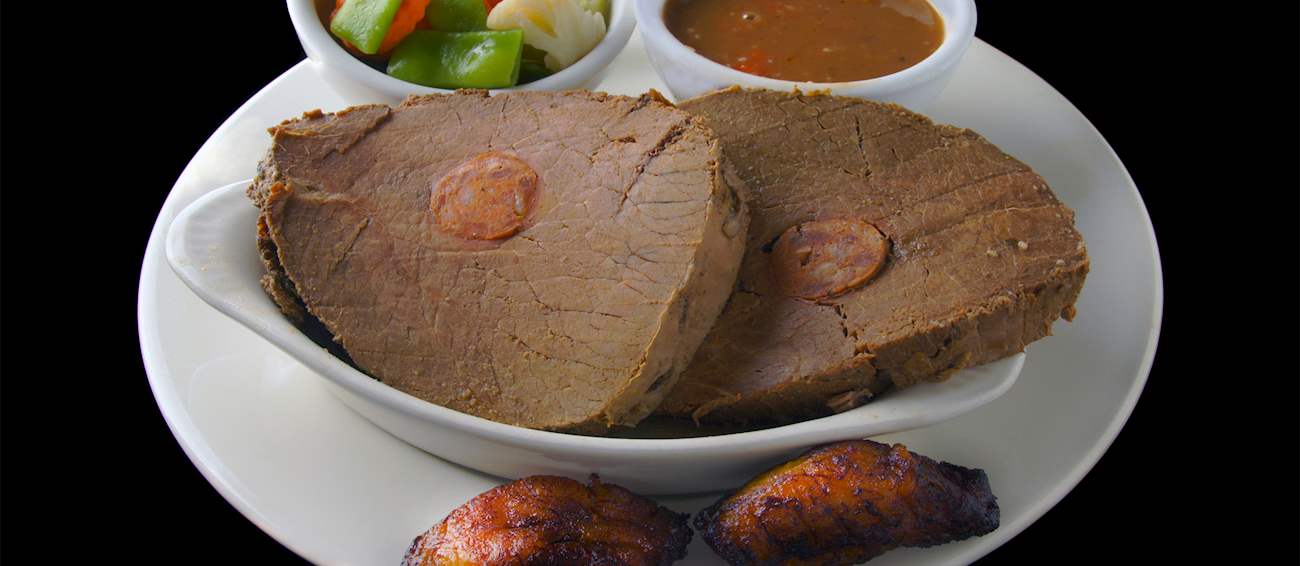MAIN INGREDIENTS
Khoresh bāmieh is a traditional stew originating from Iran. The stew is usually made with a combination of beef or lamb, tomato paste, okra, onions, garlic, tomatoes, olive oil, turmeric, cinnamon, beef stock, bay leaves, salt, and peper. The meat is browned in oil and it's then mixed with all the other ingredients except okra.
The pot is covered and the dish is simmered until the meat is tender. Near the end of cooking, okra is added to the pot and cooked until soft. The stew is served warm and it's usually accompanied by rice on the side.
MAIN INGREDIENTS
With an intriguing name translated as million steaks, this comforting Danish dish consists of ground beef that is stewed alongside onions and a variety of spices. The key is to break down the meat, as if it consists of a million tiny pieces, and to serve it with a rich, dark gravy.
This classic Danish meal is usually accompanied by mashed or boiled potatoes and beets on the side.
MAIN INGREDIENTS
Seswaa, also known as chotlho, is Botswana's national dish consisting of meat on the bone (usually beef) that's slow-cooked in salted water. Once the meat has been cooked, it is pounded with large wooden pestles, then served over pap. Seswaa is usually prepared by men due to the physical extortion during the preparation process, since the meat is cooked in traditional, three-legged pots (called potjie) over an open fire.
Lamb or goat meat can be used instead of beef, although beef is the most popular option in Botswana. Seswaa is almost always served on special occasions, weddings, and during the country's celebration of the independence day.
MAIN INGREDIENTS
Boliche is a Cuban-style pot roast, but with a distinctive twist that sets it apart from the other pot roasts: eye round or chuck roast is stuffed with chorizo and sometimes hard-boiled eggs or olives. The meat is first seared to develop a rich crust and then slow-cooked in a flavorful broth made from a base of onions, garlic, bell peppers (often referred to as the "sofrito" which is foundational in many Latin American cuisines), tomatoes, wine, and various spices.
This simmering process not only tenderizes the meat but also infuses it with the aromatic flavors of the broth. Once cooked, the meat is sliced, revealing the colorful stuffing in each slice, and served with the sauce it was cooked in. It's typically accompanied by white rice, black beans, and sometimes plantains, making for a complete and satisfying meal.
MAIN INGREDIENTS
Merimiespata is a hearty Finnish stew prepared with beef, potatoes, onions, and beer. It is typically flavored with black pepper, sugar, bay leaves, and thyme. This stew is traditionally cooked in the oven, and when the vegetables are tender and the meat is cooked, it is garnished with thyme and served.
Some say that merimiespata tastes even better when reheated the next day. If desired, the stew can be served accompanied by bread and pickled beets on the side.
A classic Swedish dish, biff à la Lindström is a piquant Swedish burger, which distinguishes itself from other burgers in its use of pickled beets and capers that add a unique flavor to it. Minced beef, eggs, chopped onions, pickled beetroots, capers, and seasonings are combined together and then formed into flat burgers, which can be either fried or grilled.
The burgers are served hot, usually for lunch, alongside boiled or roasted potatoes, green salad, kale, asparagus, or dark gravy. They can sometimes be topped with a fried egg or garnished with pickled beets and mustard. As with many classic dishes, this one also has several variations that call for mashed potatoes, breadcrumbs, heavy cream, or juice to be added to the meat mixture.
MAIN INGREDIENTS
Swiss steak is a popular American dish consisting of a round or rump steak that has been swissed, which is a technique of tenderizing the meat by pounding it. The steak is usually braised in a tomato or chile sauce, although there are numerous variations on the dish.
It is often served with mashed potatoes and gravy on the side. Because of its affordable price, Swiss steak is a staple of all-you-can-eat buffets or school and hospital cafeterias.
MAIN INGREDIENTS
Kalogeros is a traditional beef stew that's served as a casserole. It originates from Naxos. The dish is made with a combination of veal or beef chunks that have been stewed in tomato sauce, eggplants, tomatoes, Graviera cheese, cinnamon, and Myzithra cheese.
The eggplants are sliced in half and fried, then topped with the beef, Myzithra, slices of tomatoes, and Graviera cheese. The combination is sprinkled with cinnamon and baked until the Graviera cheese melts. Kalogeros is traditionally served with fried potatoes.
Orman kebabı (lit. forest kebab) is a traditional dish originating from Bolu city. The dish is usually made with a combination of lamb or beef cubes, carrots, potatoes, onions, peas, tomato paste, thyme, butter, olive oil, flour, and salt. The meat is rolled in flour and drizzled with olive oil, then browned in a pot.
The vegetables are sautéed with the butter and seasonings, covered with water, mixed with the browned meat, and the dish is then simmered over low heat until the meat is fully cooked and tender. Once done, orman kebabı is traditionally served with rice pilaf and yogurt on the side.
MAIN INGREDIENTS
Carbonada chilena is a traditional brothy stew originating from Chile. The soup-like stew is usually prepared with a combination of beef (often chuck roast), potatoes, carrots, bell peppers, celery, onions, pumpkin, corn, peas, garlic, paprika, oregano, beef stock, bay leaves, salt, pepper, and olive oil.
The ingredients are placed in a pot and simmered until the vegetables become tender and the meat is fully cooked. If desired, some cooked rice can be spooned over the dish before serving. This nourishing stew is ideal for colder days in autumn or winter, when it's eaten as comfort food.
TasteAtlas food rankings are based on the ratings of the TasteAtlas audience, with a series of mechanisms that recognize real users and that ignore bot, nationalist or local patriotic ratings, and give additional value to the ratings of users that the system recognizes as knowledgeable. For the “65 Worst Rated Beef Dishes in the World” list until March 26, 2025, 14,384 ratings were recorded, of which 10,101 were recognized by the system as legitimate. TasteAtlas Rankings should not be seen as the final global conclusion about food. Their purpose is to promote excellent local foods, instill pride in traditional dishes, and arouse curiosity about dishes you haven’t tried.






























































































